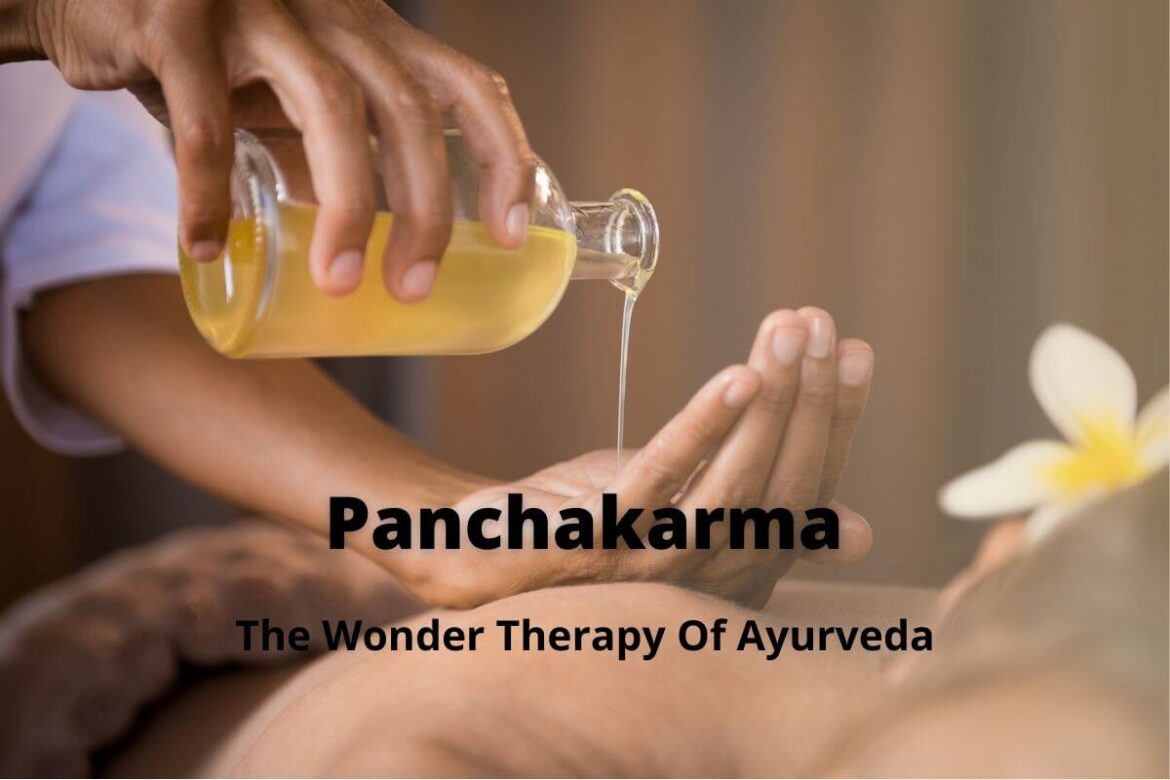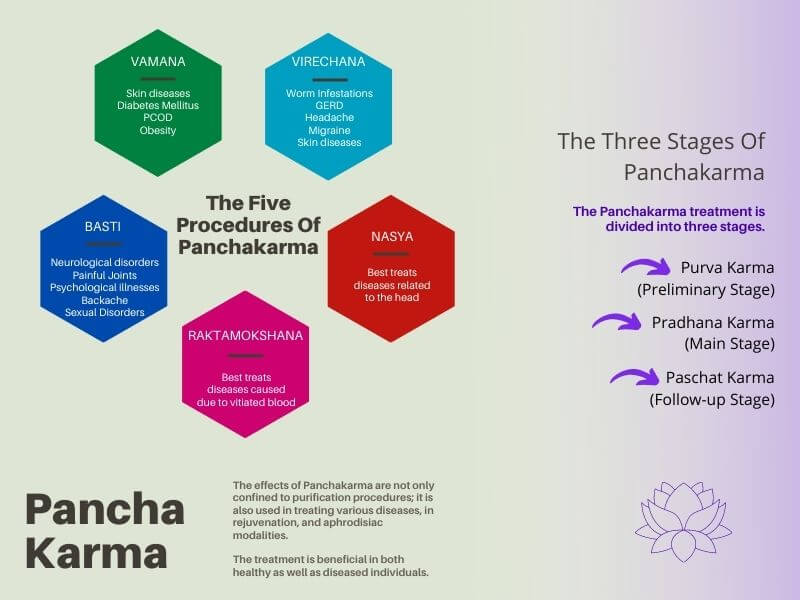Panchakarma procedure is considered to be the gem of Ayurveda sciences. This article provides you with detailed insight into the Ayurveda treatment Panchakarma, its use, importance, and effectiveness.
Ayurveda, the 3000-year old Indian medicine, has grown globally in the past few decades. Scientific efforts on understanding and validating Ayurveda procedures are prevalent in several parts of the world.
The holistic healing system of Ayurveda will be of much use to the global community when it is evidence-based; and, it is heartening to see the research studies happening around the world on various Ayurveda medicines and therapies.
Panchakarma
One of the most sought after therapies in the field of Ayurveda, the Panchakarma treatment shows much relevance not only in curing various diseases mentioned in Ayurveda classics but also in treating many contemporary chronic illnesses that other therapies could not treat.
It is one of the core modalities in the treatment of various diseases.
Many people, generally, think of Panchakarma as a purification procedure. Yes, that’s right, but not entirely correct.
The effects of Panchakarma treatment are not only confined to purification procedures; it is also used in treating various diseases, in rejuvenation, and aphrodisiac modalities.
Also Read:
Benefits The Panchakarma Therapy Offers-
The treatment is beneficial in both healthy as well as diseased individuals. Hence, anyone can attain several benefits by undergoing panchakarma procedures. Some of the general therapeutic effects are-
- Healthy living, and therefore, longevity
- Improvement in the functioning of the gastric fire thus enhancing the digestive system
- Enhancement of physical strength
- Improvement of the physique
- Immunity enhancement
- Excel in mental health and intellect
- Enhancement in sexual vigour
- Slowing down the ageing process
Now, knowing the benefits the therapy can offer, you most likely have an interest to know what to expect during the treatment.
So, read on, to get a detailed insight.
History Of Panchakarma
Acharya Charaka first gave a detailed explanation of Panchakarma therapy. Further, other authors Sushruta and Vagabhata, provided a detailed description of the treatment.
Panchakarma In Detail
The Sanskrit words Pancha and Karma make the word Panchakarma. Pancha means five, and karma means therapy or action.
Thus, Panchakarma treatment is a set of five therapeutic measures. They are Vamana, Virechana, Basti, Nasya, and Raktamokshana.
The entire Panchakarma treatment is divided into three stages.
- Purva-Karma (Preliminary procedures)
- Pradhana-Karma (Main procedures)
- Paschat-Karma (Follow-up procedures)
For a significant and proper benefit of panchakarma therapy, every stage should be followed carefully.
The image below mentions the Five procedures of Panchakarma and the diseases they can cure. It also mentions the three stages of Panchakarma Procedures.
1. Purva-Karma
It is a series of events that are essential to set an ideal stage for Panchakarma treatment. It includes Deepan, Pachana, Snehana, and Swedana.
- Deepan and Pachana:
- During this stage, the individual takes internal medications. The medicines kindle the digestive fire. Also, they prepare the body for the next set of procedures.
- Medications like Chitrakadi Vati, Shankh Vati, Sunthi Churna, Rasna Kwath, etc. are given according to the predominance of dosha.
- Snehana
- The process Snehana induces oiliness in the body. The entire panchakarma procedure’s effectiveness depends on the Snehana as it enables proper mobilization of doshas.
- Both the internal and external application of Snehana are essential in the preliminary procedure. An internal application like Ghritapana (Drinking of medicated ghee) before Vamana and Virechana procedures is vital.
- An external application like Abhyanga before every panchakarma procedure is necessary.
- Also, Snehana karma is used as Pradhana karma to pacify specific diseases or for the nourishment of the body.
- Swedhana Karma
- Swedhana karma is a procedure that induces sweat or perspiration in the body by various methods.
- This process liquefies the vitiated dosha helping it to spread all over the body and thus expelling them efficiently out of the body.
- Also used as Pradhana karma to treat diseases.
2. Pradhana Karma
Pradhana karma, a set of therapeutic procedures, when done in a specific order, promotes the elimination of toxins.
Here, toxins mean the morbid doshas responsible for diseases; Pradhana karma eliminates such morbid doshas out of the body via the nearest possible route.
The procedures of Pradhana karma are as follows:
- Vamana:
- Is a procedure that expels vitiated doshas from the body through the mouth (Vomiting induced through medicines)
- Mainly used in seasonal purification in the spring season as preventive measures
- Also used in treating diseases like Skin diseases, Diabetes mellitus, Obesity, PCOD, etc.
- Virechana:
- Is a procedure that helps expelling vitiated accumulated doshas from the body through the anal route in the way of inducing the purgation.
- Used to treat Worm infestations, GERD, Headache, Migraine, Skin diseases like psoriasis, etc.
- Basti
- Is a procedure where the doctor administers liquid medicine through the rectal, urethral, or vaginal route.
- A combination of various herbs according to disease is administered in the form of decoction or medicated oil.
- Also named Ardha-Chiktsa (half treatment) by Charaka because of its effectiveness in treating a maximum number of diseases.
- Best treats Neurological disorders, Emaciated persons, Painful joints, Psychological illness, Backache, Knee pain, Sexual disorders, etc.
- Nasya:
- A simple procedure of administering the medicines through the nasal route.
- Best treats diseases related to the head.
- Raktamokshana:
- It is a unique para-surgical procedure of letting out the blood from the body for therapeutic procedures.
- This procedure best treats diseases caused due to vitiated blood.
3. Paschat-Karma
Once Pradhana karma is done, the body is brought back to its normal physiological condition with Paschat Karma.
During this stage, specific dietary regimes with restrictions referred to as Paschat-Karma are prescribed. The Ayurveda physician plans and prescribes dietary regimes such as Peya, Manda ( specific rice preparation), Yusha, etc. according to the quantity of expelled doshas.
Also Read: Nasya – Ayurveda Therapy That Treats Several Conditions
How Long Is The Panchakarma Treatment?
One can attain the benefits of Ayurveda procedure Panchakarma according to the needs of their body. You can either take a complete administration of Panchakarma (All five procedures) or a Partial/specific administration (such as Nasya or Virechana).
A complete administration, also called the full course is for 129 days.
You can opt for an 85-days or 59-days course for specific purposes such as Rejuvenation, Diseases specific treatment, Relaxation, or Enhancing immunity.
Final Word
As you can see, Panchakarma is a unique and effective procedure of Ayurveda that can offer you general health as well as treat various conditions.
You might be a person who wants to destress or rejuvenate yourself or a person with some conditions looking for an effective medical procedure that can offer you relief and cure.
Panchakarma can be the one for you.
Also, do you wonder if you need the help of an Ayurveda practitioner to get this done? Yes.
So, if you would like to undergo this treatment, reach out to an Ayurveda practitioner and discuss the benefits you can expect from this wonderful procedure.
Edited by love4wellness | Images from canva.com

